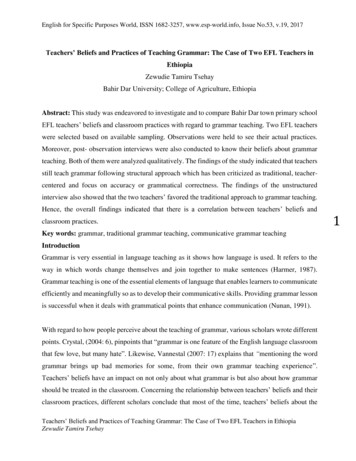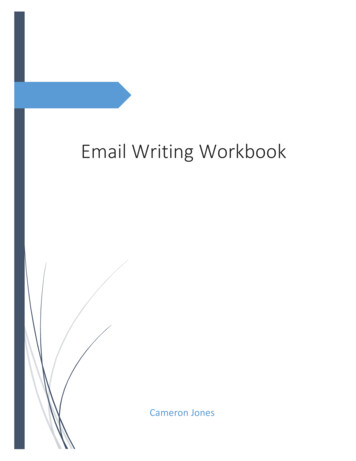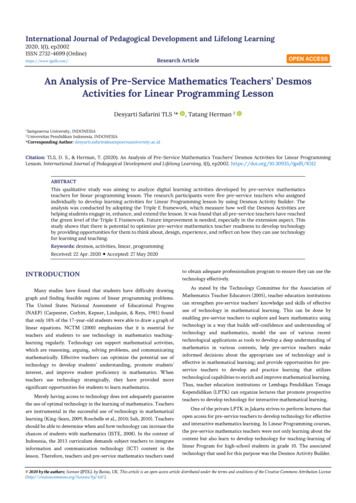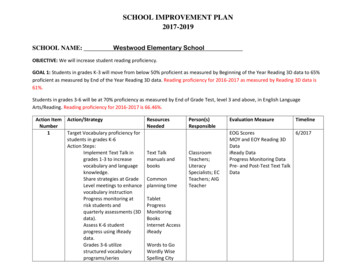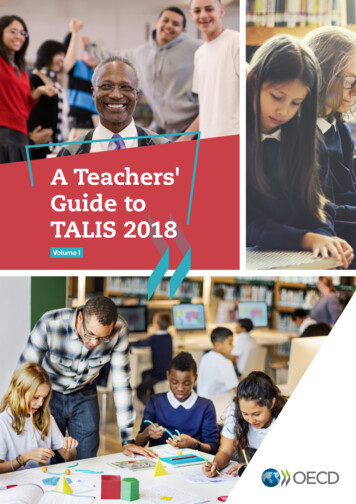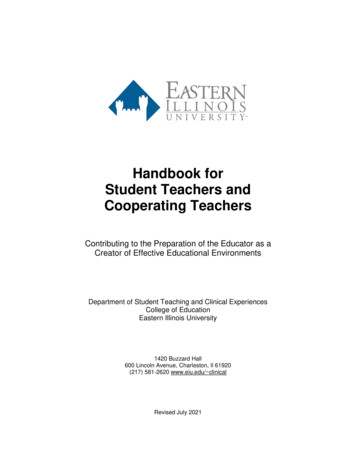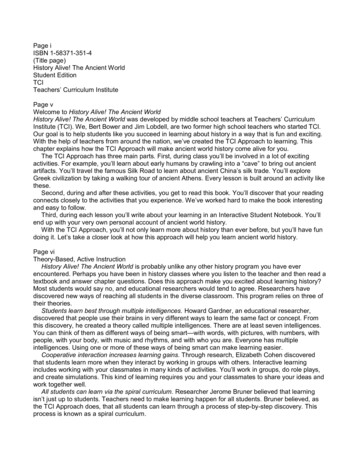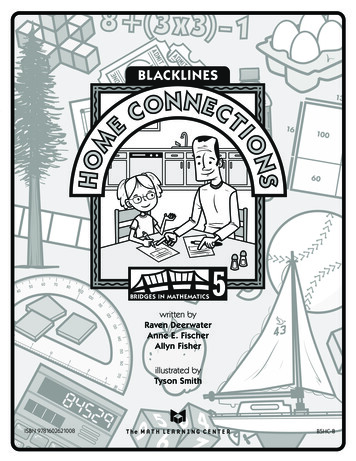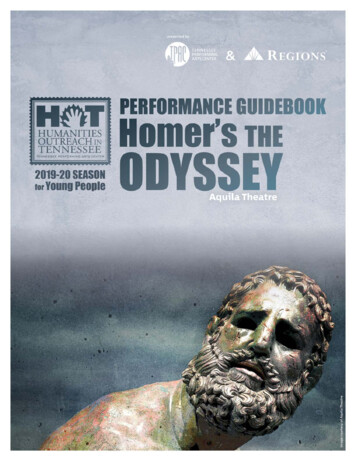
Transcription
Dear Teachers,Aquila Theatre Company believes passionately that everyoneshould be given the opportunity to engage with classicaldrama of the highest quality at an affordable price intheir own community, experience arts from other places, andexchange ideas. TPAC Education wholeheartedly agrees, andwe are thrilled to bring this performance of Homer’s TheOdyssey to our community.TABLE OF CONTENTSThe Odyssey Author and Literary Context‐ Page 1About Aquila Theatre Company ‐ Page 1The Odyssey Plot Overview ‐ Page 2This epic tale follows the warrior Odysseus as he twists andturns his way back home to the shores of Ithaca after fightinga 10‐year war at Troy. The story’s themes of homecomingand hospitality, hubris and humility, suffering and survivalcontinue to resonate across the centuries.Lesson: What is Odysseus Thinking? ‐Page 4We hope Aquila Theatre Company’s production of this classicstory will connect its viewers with these themes whileengaging them with classic literature.Lesson: The Character Journey ‐ Page 6Enjoy the show!Handout: Joseph Campbell’s The Hero’sJourney ‐ Page 10TPAC EducationLesson: What is Loyalty? ‐ Page 3Image Handout for What is OdysseusThinking? ‐ Page 5Lesson: The Hero’s Journey ‐ Page 8Handout: The Hero’s Journey in TheOdyssey ‐ Page 110
Homer’s The OdysseyAuthorHomer (c. 750 BCE) has commanded legendary status as the greatest epic poet since he first composed his twogreat masterpieces the Iliad and the Odyssey. Despite the influence his storytelling has held for millennia,scholars have failed to unearth any substantial information about his personal life. In Homer’s time, bardscomposed and performed their poetry orally. The art of writing developed in Greece around 700 BCE, andHomer’s reputation had already settled in the hearts and the minds of even the greatest literary figures of theancient world. However, scholars will likely never discover the details of his life. Nonetheless, his work remainsat the top of the western literary canon (Greek for ‘measure’). In addition, his tales have provided historianswith detailed insight into the life of the preliterate Greeks and their view of the world.Literary ContextHomer composed both the Iliad and the Odyssey in hexameters (poetic lines with six feet per measure).Because bards had to perform their epics from memory, the rhythm and structure remain tight and consistentthroughout the works. The Odyssey has 12,109 hexameters and is divided into twenty‐four bookscorresponding to the letters of the Greek alphabet. In addition to the meter and the mnemonic (Greek for‘memory’) devices of structure, bards often included standardized ways of introducing people, places, andevents. Epitaphs like “cunning Odysseus” and “grey‐eyed Athena” acted as anchors for the memory of the bardand the hearers of the tale. Powerful similes, especially comparing events to nature, made the story come tolife in an almost cinematic way for the imaginations of the ancient listeners of the tale. Even the characterdevelopment and unfolding of the events of the tale primarily followed a formula to bring about thetransformation of the characters (and the listeners) rather than blindly following a chronological or lineartelling of events. The Greek culture in Homer’s time epitomized an “honor‐shame” culture, and it is thereforeunsurprising that character and plot development moved along these lines. The plot of the Iliad follows theshaming of Achilles (problem) and ends with his glorious triumph (solution). The plot of the Odyssey createsperhaps the greatest example of the hero’s journey as it follows the protagonist Odysseus on his journey homeafter his victory with the Greeks over Troy (told in the Iliad).Aquila Theatre CompanyAquila Theatre's mission is to bring the greatest works to thegreatest number. They believe passionately that everyoneshould be given the opportunity to engage with classicaldrama of the highest quality at an affordable price in theirown community, experience arts from other places andexchange ideas.Aquila re‐examines what constitutes a classical work and, inso doing, seek to expand the canon. They endeavor to createbold reinterpretations of classical plays for contemporaryaudiences that free the spirit of the original work andrecreate the excitement of the live performance.1
PLOT OverviewTen years have passed since the fall of Troy, and theGreek hero Odysseus has not returned to his kingdomin Ithaca. A large, rowdy mob of suitors have overrunOdysseus’s palace, pillaged his land, and courted hiswife, Penelope. Prince Telemachus, Odysseus’s son,wants desperately to throw the suitors out but doesnot have the confidence or experience to fight them.One of the suitors, Antinous, plans to assassinate theyoung prince, eliminating the opposition to theirdominion over the palace.Unknown to the suitors, Odysseus is still alive. The beautiful nymph Calypso, possessed by love for him, hasimprisoned him on her island. He longs to return to his wife and son, but he has no ship or crew to help himescape. While the gods and goddesses of Mount Olympus debate Odysseus’s future, Athena resolves to helpTelemachus and prepares him for a great journey to Pylos and Sparta. Here, the kings Nestor and Menelausinform him that Odysseus is alive and trapped on Calypso’s island.On Mount Olympus, Zeus sends Hermes to rescue Odysseus from Calypso. Hermes persuades Calypso to letOdysseus build a ship and leave. The homesick hero sets sail, but when Poseidon, god of the sea, finds himsailing home, he sends a storm to wreck Odysseus’s ship. Athena intervenes to save Odysseus from Poseidon’swrath, and the he lands at Scheria, home of the Phaeacians, and receives a warm welcome from the king andqueen. When he identifies himself as Odysseus, his hosts are stunned. They have heard of his exploits at Troyand promise to give him safe passage to Ithaca if they can hear the story of his adventures.Odysseus spends the night describing the fantastic chain of events leading up to his arrival on Calypso’s island.He recounts his trip to the Land of the Lotus Eaters, his battle with Polyphemus the Cyclops, his love affair withthe witch‐goddess Circe, his temptation by the deadly Sirens, his journey into Hades to consult the prophetTiresias, and his fight with the sea monster Scylla. When he finishes his story, the Phaeacians return Odysseusto Ithaca, where he seeks out the hut of his faithful swineherd, Eumaeus. Though Odysseus is disguised as abeggar, Eumaeus warmly receives and nourishes him in the hut. He soon encounters Telemachus, who hasreturned despite the suitors’ ambush, and reveals his true identity. Together, they create a plan to massacrethe suitors and regain control of Ithaca.When Odysseus arrives at the palace the next day, still disguised as a beggar, Penelope takes an interest in thisstrange man, suspecting that he might be her long‐lost husband. Penelope organizes an archery contest thefollowing day and promises to marry any man who can string Odysseus’s great bow and fire an arrow througha row of twelve axes—a feat that only Odysseus has ever been able to accomplish. At the contest, each suitortries to string the bow and fails. Odysseus steps up to the bow and easily fires an arrow through all twelve axesbefore turning the bow on the suitors. He and Telemachus, assisted by a few faithful servants, kill every suitor.Odysseus reveals himself to the entire palace and reunites with his loving Penelope. He travels to see his agingfather, Laertes. They come under attack from the vengeful family members of the dead suitors, but Laertes,reinvigorated by his son’s return, successfully kills Antinous’s father and puts a stop to the attack. Zeusdispatches Athena to restore peace. With his power secure and his family reunited, Odysseus’s long ordealcomes to an end.2
Lesson – What Is Loyalty?Written by Terry Occhiogrosso.OBJECTIVES: The student will define loyalty and list character traits of loyal people.The student will evaluate limits (or the lack of limits) of loyalty.The student will create a scene depicting loyalty.WARM‐UP: What does the word loyalty mean to you? If two people were in a relationship and agreed to remain loyalto each other what might that mean? Talk about various definitions of loyalty. Have all the students stand together in a line on one side of the room. Explain that you have somequestions that you would like each student to answer for themselves; there is no right or wrong answer tothese questions. This side of the room shows that we agree with a question. If our answer is “yes” to thequestion being asked, we stand here. Next have students walk to the opposite side of the room. This side of the room shows that we DON’Tagree with a statement that is being given, this is our “no” position. If this side is “no” and that side is“yes,” where do you think “maybe” or “sometimes” might be?” Once students understand the activity fully, ask the following questions, and the students “answer” thequestions by going to the position in the room that corresponds to their answer. 1. I know what it’s like to be away from someone I care about.2. It’s hard to be away from someone you care about for an extended period of time.3. If I had to be away from the person I cared most about for a month, (this could be aboyfriend/girlfriend/best friend) without any contact (no email, no phone calls, no letters) Iwould remain loyal to them.4. If I had to be away from the person I care about most for 1 year, I would remain loyal to them.5. If I had to be away from the person I care about most for 5 years, I would remain loyal to them.6. If I had to be away from the person I care about most for 10 years, I would remain loyal to them.Have students return to their seats. Discuss the activity: What did you notice about yourself during thisactivity? What did you notice about the group? By the end of this activity most of you were standing muchmore in the “no” area, (if they were) why do you think someone wouldn’t remain loyal to someone else forten years? Odysseus and Penelope were separated for twenty years. Think about that!INSTRUCTIONAL PROCEDURES: Break class into groups of 4‐5 and create scenes that depict what they think would happen in the givenscenario.Requirements for the scene:o Create a scene that shows what may have happened if Penelope thought that Odysseus was nevercoming home.o All students must be either an actor or a director (only one director per group).o The scene must clearly depict what the group believes happened in the scenario they chose.o The groups may use anything in the classroom, with the teacher’s permission, as props for their scene.o Each group will perform their scene for the class.REFLECTION: How did the groups clearly show their ideas about what might happen? How did doing thisactivity change your ideas about loyalty?3
Lesson – What Is Odysseus Thinking?Written by Terry Occhiogrosso.OBJECTIVES:The student will describe how thoughts and feelings may be expressed visually.The student will identify challenges that Odysseus faces in Homer’s The Odyssey.The student will create frozen stage pictures to tell a story from The Odyssey.MATERIALS NEEDED: Students will need to have knowledge of The Odyssey, images from the following pageWARM‐UP: When students arrive, have the photos on the following page posted in the front of the room, or havecopies provided at their desks. As a class, ask students to share some of their initial reactions from looking at these images. What do theynotice? What do they wonder? Next ask students to work in pairs and write down more detailed responses to the images. Students shouldinclude information about what they can tell about the characters, the setting and action, and what eachcharacter is thinking or feeling. After pairs have had time to make notes about the images, discuss as a class. Ask students to share whatthey identified about each character and situation, and what the characters are thinking and feeling. Whatinformation did students gather just from looking at these still images? What additional information doyou still need to understand the story?INSTRUCTIONAL PROCEDURES: Ask students for scenes from The Odyssey that depict some of Odysseus’s challenges (Circe imprisoninghim; Meeting the Cyclops; Poseidon wrecking his ship; The Sirens; etc.). Write the suggestions on theboard. Get as many as possible. Break students into groups of 3‐4 and have them pick one idea and ask them to explore that idea throughthe creation of three frozen stage pictures (or tableaus) that tell what is happening in the scene to thecharacters at the beginning, middle, and end of the story.Requirements for the tableaus: Every student in each group participates in the frozen tableau. They must have 3 separate tableaus, a beginning, a middle and an end of their scene. Each group will show their stage pictures to the class. Give students time to rehearse. Encourage them to consider what each character is thinking and feeling,even though the tableau is frozen, and to use that to influence their facial expressions and movements.Students share their tableaus with the class. During the sharing of the frozen tableau, hold a hand over acharacter’s head and invite students in the audience to speak an inner thought for the character (thestudent playing the frozen character remains silent): What do we think this character might bethinking? What else could this character be thinking? Select one character per frozen image.REFLECTION: What did we learn when we added internal thoughts to our frozen images? For those of you in theimages, how did you embody the emotions, ideas, or thoughts of your character? How do a character’s inner thoughts and feelings help us better understand the story we areexploring?4
Warm-Up Images for – What Is Odysseus Thinking?Siren by Michael Creese.Image of Poseidon from The Odyssey: A Graphic Novel byGareth Hinds.Image from The Wanderings of Odysseus by Rosemary Sutcliff, Illustrated by Alan Lee.5
Lesson – The Character JourneyWritten by Alex Wallace and Austin Cagle.LEARNING OBJECTIVES:The student will identify 12 parts of Joseph Campbell’s Hero’s Journey.The student will discuss the importance of the Hero’s Journey in developing characters through writing.The student will discuss the importance of the Hero’s Journey in developing characters through acting.MATERIALS NEEDED: paper and writing utensilWARM UP: Share the following quote with the class: “At its core, the hero’s journey is one of transformation – wherea character gains awareness, overcomes the resistance to change, and embarks on a path to self‐discovery.” Quickly have each student think/pair/share a defense of this idea (this idea is right because etc.),focusing particularly on the statement about transformation. Discuss: Why do fictional plays, movies, books, and television shows have characters? Truly think aboutthat. Could a story happen without a character? Would you want it to? Fictional stories typically only workbecause they are happening to someone or something that has human qualities. These stories resonatewith us. Every human on the planet wants the character in a story to be able to change or grow, becausethey know secretly that if the main character can do it, so can they. As a class, identify some examples of character transformations in well‐known stories, such as HarryPotter, Spiderman, The Beast in Beauty and the Beast, Elphaba in Wicked, Ebeneezer Scrooge in AChristmas Carol, Pinocchio, Rapunzel in Tangled, Simba in The Lion King, or Odysseus in The Odyssey. Again have the students think/pair/share this follow up question: In what ways could an actor visualizethese types of transformations? Discuss: Seeing a character change along the course of the “journey” of their story is arguably one of themost important aspects of any piece of fiction, theatrical or otherwise. As an actor, it is our job to portraythis character transformation, not only in our minds but physically to our audience. You may knoweverything there is to know about your character, but how would the audience know?INSTRUCTIONAL PROCEDURE: Have your students draw a large circle on a piece of paper. Next split the circle in half with a horizontalline. Label the top half Ordinary and the bottom half Adventure. Next, split the circle in half again this timewith a vertical line, you should have four quadrants. Each point at which a line touches the edge of thecircle corresponds with one of the 12 steps in Joseph Campbell’s Hero’s Journey, label those fourappropriately now (12 – Status Quo, 3 – Departure, 6 – Crisis, 9 – Return). As a class, have students choose a main character from a story or play that the entire group is familiarwith. This could be one you discussed earlier in the lesson, or a new option. Next, briefly describe and record the specifics of the plot from your story just at those four points. Break the class into small groups. Based on what they know about the character, have them describe thefollowing attributes about the character in each of the four quadrants (it’s okay if you have chosensomeone who the class has actually never seen before, let the students make those decisions then):6
Physical Posture, Body Language/Gestures, Vocal Size (are they loud and commanding or soft spoken, etc.),Vocal Speed.**Teachers Note: This exercise is meant to help the students identify tangible changes that they canimplement on stage for their character after certain events. If students choose to write the same thing inall four quadrants, use this as a teachable moment. Would this be an interesting character to watch?Probably not, because they are static unchanging and therefore uninteresting and not worth our attention.What we have just created is a tool for you to use on almost any character one could ever play on stage.You have given yourself real tangible goals to put into place as an actor that help you communicate alogical/seeable change based on the plot of the play.Ask groups to share their ideas with the group.REFLECTION: Did anyone have an idea that surprised you? What choices can actors make to clarify theirtransformation to the audience? What transformations do the characters in The Odyssey go through?RESPOND TO THIS QUOTE: “Does every play have to follow this structure [the hero’s journey]? Of course not,but for plays that do, it’s the key to knowing what a character wants and why the audience should care. Welike when characters change, we like when they transform as people‐ that’s what keeps the audience invested.The audience buys tickets because of the first half of a play; they stay because of the second half.” (DavidLindsay‐Abaire)EXTENSION: Ask for volunteers to demonstrate their work as an actor in front of the class. You will need 4 volunteers toeach represent one of the quadrants during the character journey that show the transformation as afrozen image.7
Lesson – The Hero’s JourneyAdapted from a lesson by Alex Wallace and Austin Cagle.LEARNING OBJECTIVES:The student will compare and contrast heroes and their journeys through various stories.The student will apply the elements of Joseph Campbell’s Hero’s Journey to Homer’s The Odyssey.The student will evaluate the importance of the Hero’s Journey in literature and theater.MATERIALS NEEDED: Students will need to have prior knowledge of The Odyssey; copies of The Hero’s Journeyin The Odyssey handout provided on page 11; copies of the handout Joseph Campbell’s “The Hero’s Journey”provided on page 10 (optional)WARM UP: Begin by asking students to brainstorm a list of heroes. Let them know that comic book superheroes,movie heroes, and famous people from history are acceptable options. Then, discuss the qualities of ahero. What makes them heroic? Their character traits? The things that happen to them? How theyrespond to those events? All of the above? Ask students to think of their favorite fictional story. Some suggestions might include: Star Wars, HarryPotter, The Lion King, The Lion, The Witch, and The Wardrobe, Moana, The Wizard of Oz, Superman, or ThePrincess Bride. What do stories about ancient Greek heroes, wizards, animals, and superheroes have incommon? While they may seem different, author Joseph Campbell claims they are all variations of thesame story. In his 1949 book, The Hero with a Thousand Faces, Campbell outlines the monomyth, orarchetypal hero journey, that all of these stories follow. Put students in groups of three or four and ask them to make a list of what these stories and their heroeshave in common. Allow for brief discussion within groups before letting students share their ideas.Encourage students as they make connections (such as the presence of a central character who takes ajourney, a series of adventures, magical elements, and so forth). Next ask students to select one of the stories discussed and answer the following questions. Read out thefollowing questions and have students answer yes or no about their selected story:o Does your story start with the main character living a normal (for them) life?o Does something happen that causes or asks the main character to depart their normal life?o Does the main character receive help from a mentor figure, or ally?o Does the main character enter a world or situation they are unfamiliar with?o Does the main character encounter a series of tests or obstacles by which they grow from?o Does the main character ultimately have to face their greatest obstacle or fear, or combat againsta major setback?o Does the main character encounter a “darkest moment” where they face death or defeat, or arethey defeated and are reborn stronger than they were?o Does the main character receive some type of reward or knowledge?o Is the main character or their surroundings changed upon completion of their biggest obstacle?o Does the main character return to their original “life”?o Does the main character begin a new life using knowledge or reward gained from their ordeal? Discuss: Though not every story will have a clear example of each of these questions, regardless of thestory you chose you probably answered yes to most of these questions.8
INSTRUCTIONAL PROCEDURES: Introduce the idea of Joseph Campbell's monomyth, or hero's cycle, to your students. Campbell claims thatmost great heroes have taken the path of this hero's journey, which fall into 3 main stages ‐ departure,initiation, and return. These are further broken down into additional steps. Share the steps of the hero’scycle with students, either copying the handout provided on page 10 orThis lesson uses a simplifiedby using a method of your choice. The hero cycle is prominent in Greekmythology, so choose a hero like Hercules, Jason, Perseus, or Theseusversion of Campbell’s monomyth,and walk students through the journey they took while looking at thewhich includes 12 steps. Somesteps, identifying the various stages.versions include up to 17 steps. Next let us look at one of the greatest pieces of narrative fiction evercreated, The Odyssey, and see if we can apply the steps of the hero’sjourney. The Odyssey was written by the Ancient Greek Poet Homer in or around 750 B.C.E. Comprised of24 volumes, it tells the story of Odysseus, and his ten‐year long journey back from the famed Trojan War.Give students a copy of the handout provided on page 11. Ask students to label the chart and give a brief description of each step of the hero’s journey in TheOdyssey.REFLECTION: After students have filled out their steps, discuss them as a class. Were any of the steps missing, out of order, or slightly different from the normal stages? Did students identify different story elements than a classmate for the same steps? Discuss the exit ticket question – Why would The Hero’s Journey be important to writers or actors? Whatbenefits or challenges does it raise?EXTENSIONS: Consider using contemporary texts to bridge the gap between the themes of a classical epic and the issuesthat are more immediately familiar to students. A book like Running Out of Summer has interestingcontemporary comparisons with The Odyssey. Give students a list of books they can read to analyze for the use of the monomyth. Below are a fewexamples at different reading levels: A Wrinkle in Time by Madeleine L'Engle Alice in Wonderland by Lewis Carroll Dragon Wings by Laurence Yep Eragon by Christopher Paolini Harry Potter and the Sorcerer's Stone by J.K. Rowling Hunger Games by Suzanne Collins Mrs. Frisby and the Rats of NIMH by Robert O'Brien Percy Jackson and the Olympians by Rick Riordan The Dark is Rising by Susan Cooper The Hobbit by J.R.R. Tolkien The Lion, The Witch, and The Wardrobe by C.S. Lewis The Wizard of Oz by L. Frank Baum Introduce the Hero’s Journey by using fun picture books, then ask students to create their own picturebook of The Odyssey, making sure to include each of the steps in the Hero’s Journey. Some funsuggestions for pictures books are: The Hero and the Minotaur: The Fantastic Adventures of Theseus by Robert Byrd Jason and the Golden Fleece by Leonard Everett Fisher Beowulf: A Hero’s Tale Retold by James Rumford Tales of King Arthur by Hudson Talbott The Gilgamesh Trilogy by Ludmila Zeman Shrek! By William Steig9
Joseph Campbell’s “The Hero’s Journey”1) Ordinary World: Status Quo; The hero’s normal life at the start of the story.2) Call to Action: The hero is faced with something that creates a need to begin an adventure.3) Refusal of the Call: The hero initially refuses the call, before realizing the need.4) Assistance: The hero encounters a mentor, someone who can give advice and help with the journey.5) Departure: The hero leaves their ordinary world and crosses the threshold into adventure.6) Trials: The hero learns the rules of their new world, faces challenges, and gathers both allies andenemies alike.7) Approach: Setbacks occur, sometimes causing the hero to try a new approach or adopt new ideas.8) Crisis: The hero experiences a major hurdle or obstacle, such as a life or death crisis.9) Reward: After surviving trials and dangers, the hero earns rewards and/or accomplishes the goal.10) Road Back: The hero begins the journey back to ordinary life.11) Resurrection: The true climax of the story; The hero faces a final test where everything is at stakeand must use everything learned in the journey.12) Return: Status Quo; The hero finally returns home, having grown and matured during the journey.Image from reedsy.com10
The Hero’s Journey In The Odyssey12 ‐11 ‐1‐2‐10 ‐3‐9‐4‐8‐7‐5‐6–Exit TicketHow could the hero’s journey be used as an important tool for both writers and actors?11
Special ThanksTennessee Performing Arts Center’s nonprofit mission is to lead with excellencein the performing arts and arts education, creating meaningful and relevantexperiences to enrich lives, strengthen communities, and support economic vitality.TPAC education programs are funded by generous contributions, sponsorships, andin-kind gifts from our partners.Season Sponsor511 Group, Inc.Advance FinancialJulie and Dale AllenAnonymousAthens Distributing CompanyBank of AmericaThe Bank of America CharitableFoundation, Inc.Baulch Family FoundationMr. and Mrs. Robert E. Baulch Jr.Best Brands, Inc.BlueCross BlueShield of TennesseeBonnaroo Works Fund*Mr. and Mrs. Jack O. Bovender Jr.Bridgestone Americas TireOperations, LLCBridgestone Americas Trust FundBrown-FormanButler SnowCaterpillar Financial ServicesCorporationChef’s Market Catering& RestaurantCity National BankCMA FoundationCoca-Cola Bottling CompanyConsolidatedThe Community Foundation ofMiddle TennesseeCompass Partners, LLCCoreCivicDelta Dental of TennesseeDisney Worldwide Services, Inc.Dollar General CorporationDollar General Literacy FoundationDollywoodEarl Swensson Associates, Inc.The Enchiridion FoundationDr. and Mrs. Jeffrey EskindDavid P. Figge andAmanda L. HartleyGoogle, Inc.Mr. and Mrs. Joel C. GordonGrand Central BarterHCA Inc.HCA – Caring for the CommunityJohn Reginald HillHiller Plumbing, Heating,Cooling and ElectricalHomewood SuitesNashville DowntownIngram IndustriesMartha R. IngramThe JDA Family Advised Fund*The Jewish Federation ofNashville and Middle TennesseeJohnsonPossKirbyLiberty Party RentalMary C. Ragland FoundationMEDHOSTThe Memorial FoundationMetro Nashville ArtsCommissionMonell’s Dining and CateringNashville Convention andVisitors CorporationNashville LifestylesNashville OriginalsThe NewsChannel 5 NetworkNissan North America, Inc.NovaTechKathleen and Tim O’BrienMaria and Bernard ParghPublix Super Markets CharitiesMr. and Mrs. Ben R. RechterAdditional AcknowledgementsThis performance is presented through arrangementsmade by Baylin Artists Management.Cover image courtesy of Aquila TheatreRegions BankRyman HospitalityProperties FoundationSargent’s Fine CateringService Management SystemsLisa and Mike ShmerlingSunTrust FoundationRhonda Taylor andKevin ForbesThe TennesseanTennessee Arts CommissionJudy and Steve TurnerNeil and Chris TylerVanderbilt UniversityWashington FoundationDr. and Mrs. Philip A. WenkJerry and Ernie WilliamsWoodmont Investment Counsel, LLC*A fund of the Community Foudationof Middle Tennessee
4 Written by Terry Occhiogrosso. OBJECTIVES: The student will describe how thoughts and feelings may be expressed visually. The student will identify challenges that Odysseus faces in Homer's The Odyssey. The student will create frozen stage pictures to tell a story from The Odyssey. MATERIALS NEEDED: Students will need to have knowledge of The Odyssey, images from the following page

